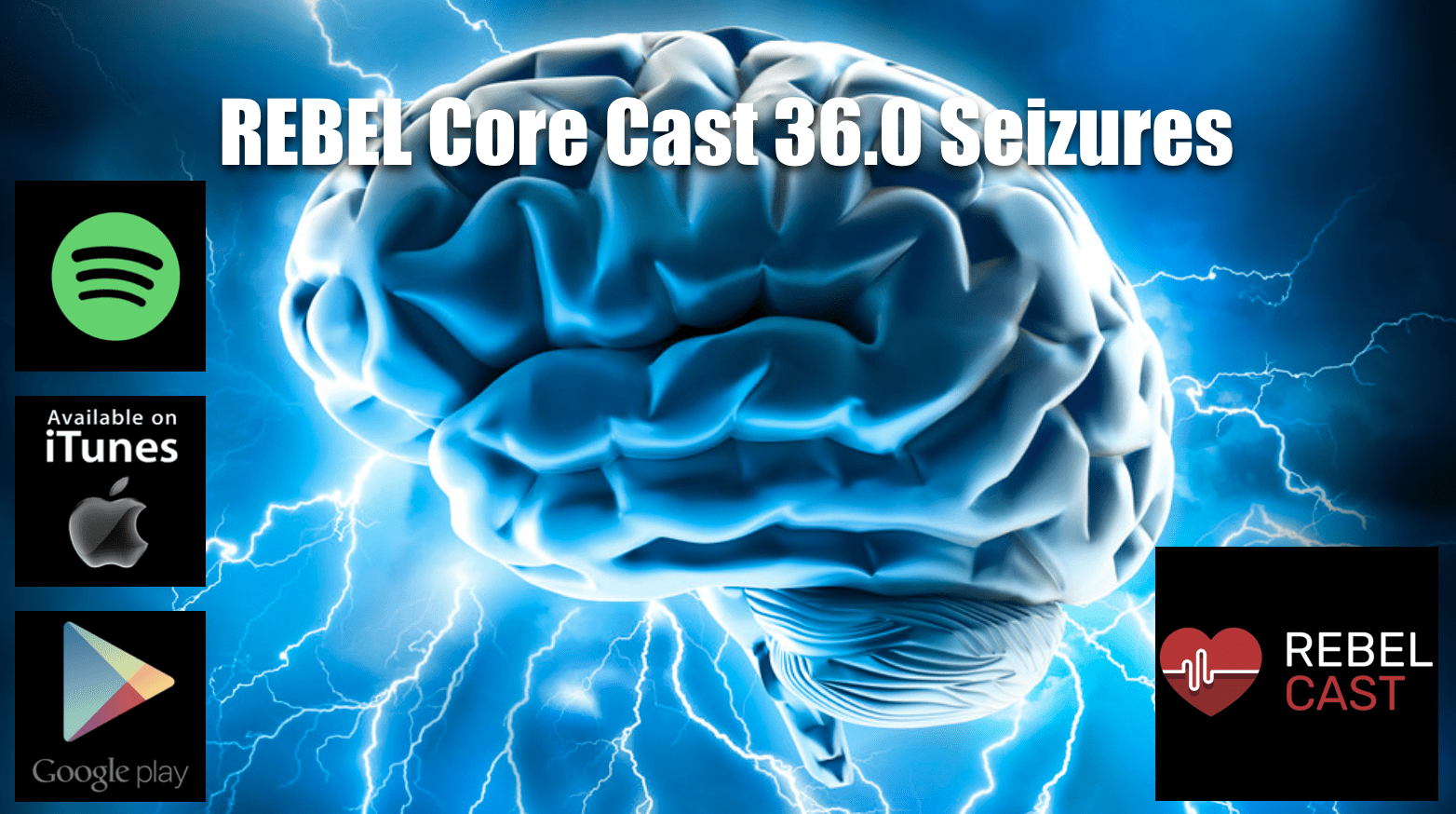
 Take Home Points
Take Home Points
- When approaching the patient with uspected seizure, focus on questions that matter in determining if the event was a seizure or not
- Extensive lab work after a first time seizure is not necessary in patients who are back to baseline. Focus on serum glucose, determining pregnancy/postpartum status, and in patients who continue to seize, check that sodium!
-
Get a CT of the Head on
- First-time seizure patients
- High-risk groups (alcoholics, immunocompromised, infants < 6 months of age)
- Those with an abnormal neuro exam
- Those presenting with focal seizures
- Psychogenic non-epileptic seizures are difficulty to distinguish from true epilepsy and there is significant overlap between the two conditions. Take all seizure activity seriously.
- Give clear discharge instructions to your first-time seizure patients and close the loop on close neurology follow-up.
REBEL Core Cast 36.0 – Seizures
Seizures:
- Definition – an episode of disturbed cerebral functions characterized by excessive and synchronous discharges by cortical neurons
-
2 types
- Provoked – attributable to an apparent cause (electrolyte disturbance, drug/EtOH withdrawal, eclampsia)
- Unprovoked – no identifiable cause
- Convulsions – the motor manifestations of the abnormal brain activity
- No single ED test or information from the history is 100% diagnostic of a seizure
Seizure mimics:
- Syncope (20% will be convulsive syncope)
- Convulsive concussion
- Posturing
- Psychogenic non-epileptic spells (PNES)
- certain TIAs
- other neurologic movement disorders
Characteristics that are non-diagnostic of seizure:
- urinary incontinence
- lightheadedness prior to the event
- paresthesias
- activity prior to the event
- headache after
- sustaining an injury
Characteristics that are helpful (make seizure more likely)
- lateral tongue biting
- eyes open during the episode
- post-event confusion
- a forward or unilateral gaze during the episode
First-time seizure ED work-up:
-
POC glucose!
- Most common cause of provoked seizure
- ECG (to rule out dangerous mimics)
-
FULL vital signs!
- temperature, blood pressure, oxygen saturation
-
Pregnancy/Postpartum status
- up to 6 weeks postpartum at risk for eclampsia
-
Sodium level
- especially if seizure is not resolved
-
CT of the head
- may change management in the ED up to 17% of the time
- Let the patient’s medical, social, and medication history dictate any further workup
High-risk groups in which to always get a CTH:
- Those not back to baseline
- Chronic alcohol use
- Immunocompromised
- Infants < 6 months of age
- Those with an abnormal neuro exam
- Those with focal seizures
- Recent neurosurgical intervention/instrumentation
Psychogenic Non-Epileptic Seizures (PNES)
- Involuntary episodes NOT associated with abnormal cerebral discharges
- Often associated with a history of PTSD, abuse
- Triggering event is not usually readily identifiable
- Between 5-60% of patients diagnosed with PNES will ALSO have a concurrent diagnosis of epilepsy
- PNES does not equal malingering
Features of PNES:
- long duration
- gradual onset
- asynchronous movements
- closed eyes
- pelvic thrusting, leg bicycling
- moaning or talking through episode
- side to side head & body movements
- ictal crying
- absence of postictal period
- postictal stertorous breathing
Disposition for first-time seizures:
- If back to baseline, relevant labs and CTH normal, patient can be discharged
-
Prompt follow-up with Neurology for EEG should be available
- sensitivity of the EEG declines the further in time from the episode
-
AED prescription/loading is NOT necessary in patients with unprovoked first-time seizures
-
consider (in conjunction with Neurology colleagues) starting an AED in patients at higher risk of recurrent seizure
- prior stroke or TBI
- significant neuro-imaging abnormality
- nocturnal seizure
-
consider (in conjunction with Neurology colleagues) starting an AED in patients at higher risk of recurrent seizure
Discharge instructions:
- No bathing or swimming alone
- No bathing children alone
- No driving until cleared by a neurologist
- Local/state laws differ across the country, but realize that they many require you as the physician to report seizures to the DMV
- Prompt follow-up with a neurologist for EEG
Post Peer Reviewed By: Salim R. Rezaie, MD (Twitter: @srrezaie)
The post REBEL Core Cast 36.0 – Seizures appeared first on REBEL EM - Emergency Medicine Blog.
